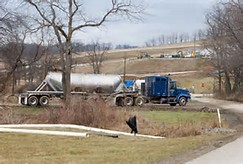Study finds lower birth weight babies near Penna. gas sites
From an Article by Ken Ward, Jr., Charleston Gazette, June 3, 2015
Women living close to a high-density of natural gas operations were more likely to have babies with lower birth weights than women living farther from such operations, according to a new study from researchers at the University of Pittsburgh.
The study from Pitt’s Graduate School of Public Health does not argue that proximity to gas wells caused the lower birth rates, but reports an “association” that emphasizes the need for more and larger such examinations to “evaluate the potential public health significance” of the boom in natural gas in the Marcellus Shale region.
“These things are important clues that more work needs to be done,” said Bruce Pitt, chairman of Pitt’s Department of Environmental and Occupational Health. “There really is a dearth of evidence-based research.”
While the Pitt study focused on wells in three southwestern Pennsylvania counties, it comes as West Virginia citizen groups continue to push for the state to act on a series of legislatively mandated reports that concluded more protections are needed for residents in the areas where Marcellus gas production has been booming.
“It is past time for the state to act on the recommendations of the studies mandated by the Horizontal Well Control Act, which include air quality monitoring to control emissions,” said Julie Archer, project manager for the West Virginia Surface Owners Rights Organization.
In the Pitt study, researchers cross-referenced the birth outcomes for more than 15,000 babies born in Washington, Westmoreland and Butler counties between 2007 and 2010 with the proximity of their mother’s homes to wells drilled using horizontal drilling and hydraulic fracturing technologies. They divided the data into four groups, depending on the number and proximity of wells within a 10-mile radius of the mother’s homes.
Mothers whose homes were closest to a high density of wells were 34 percent more likely to have babies who were “small for gestational age” than mothers whose homes fell in the bottom 25 percent, the study said.
The term “small for gestational age” means refers to babies whose birth weight ranks them below the smallest 10 percent of babies born at the same gestational age. The term is distinct from “low birth weight,” which is defined as a birth weight of less than 5.5 pounds, regardless of gestational age.
Generally, lower birth weight can put babies at risk of being born prematurely, and it can also be related to infections and a variety of chronic illnesses. The Pitt study, though, did not find a significant association between proximity and density of wells and prematurity. A previous study of 125,000 births in Colorado found an association between closer proximity to a density of wells and an increase in the prevalence of congenital heart defects, but also found an increase in birth weights associated with well density.
Authors of the Pitt study conceded that they didn’t have exact data about exposures to any pollution from wells, and used proximity as a surrogate for exposure figures. “Active drilling of a well occurs over a period of only a few months, so incorporating more specific timings of exposure will be critical in future work as further data become available as to the time period during which air or water exposures are most likely,” the study said.
Michael McCawley, a West Virginia University researcher who has been looking into gas drilling impacts in the state, said that the new Pitt study is consistent with the kinds of concerns his work has raised about impacts on public health and the need for more studies.
A new study by McCawley, for example, found that air pollution from truck traffic associated with drilling, hydraulic fracturing and gas production needs to be more closely examined for potential public health impacts.
“Not all of the pieces of the puzzle are there yet,” McCawley said Wednesday.
The Pitt study was published online Wednesday in PLOS ONE, a journal that is peer-reviewed but focuses on quick turnaround and publication of scientific papers once they are reviewed.
The study was funded by the Heinz Endowments, whose work supporting such research has been criticized by oil and gas industry groups, and shortly after the Pitt paper was published Wednesday, the Marcellus Shale Coalition posted a statement criticizing its methods and findings.
See also: www.FrackCheckWV.net


{ 1 comment… read it below or add one }
Pitt study shows link between fracking, lower birth weights
PITTSBURGH — University of Pittsburgh researchers say a groundbreaking study focusing on southwest Pennsylvania released Wednesday shows that pregnant women living near natural gas fracking wells are more likely to have babies with lower birth weights.
Dr. Ellen Wells says: A quick glance suggests that there are many other differences between those living closer to wells vs those living farther away from wells … the authors would have needed to be very careful to be able to eliminate those as potential confounders. This is interesting, but I’d like to see more than this to make up my mind about the issue.